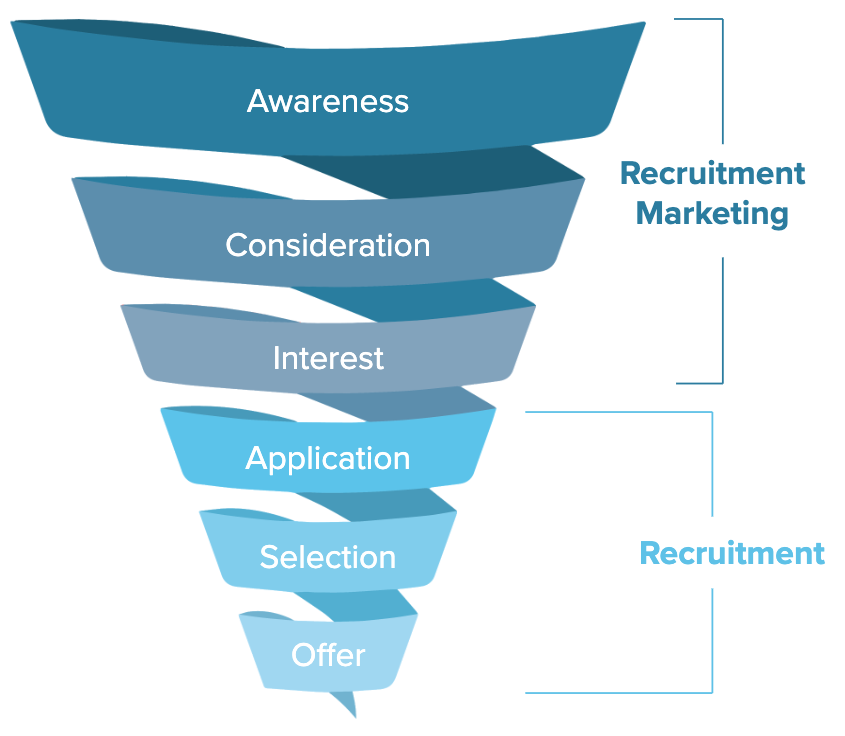Cast your minds back to earlier this year: we had record low unemployment, and recruitment teams across the country were frantically trying to fill hundreds of open requisitions, under intense pressure to find quality talent or to somehow pull these individuals out of a hat.
Who would have thought then that we would be in the midst of a pandemic, with 22 million people unemployed in the US. Whilst this time brings uncertainty and a shift in recruitment activities, it also presents an opportunity for recruitment teams to reflect, review and refresh their top of the funnel recruitment marketing strategies.
You might ask ‘Why should recruitment teams focus their energy on Recruitment Marketing during this time?’
Quality talent is still looking for great opportunities and to build connections with either your organization or your competitors. Now more than ever, it is critical to keep your passive and active candidates engaged, nurtured and informed. Recruitment Marketing can help you with this and so much more.
The one thing we do know for sure is that when the ‘curve has flattened’ and we come out the other side of this pandemic, organizations will look to remobilize their workforce quickly. Recruitment teams will need to be armed and ready with talent-rich pipelines to meet the recruitment demands of their key stakeholder groups.
Those who come out of this successfully will have had savvy recruitment teams adopting a strategic mindset during this time. These strategic teams are currently using recruitment marketing tactics and technology to attract, engage, build and nurture rich pipelines of talent, ready to convert into successful hires when their organization is ready.
This blog provides insight into not only what Recruitment Marketing is, but also delivers a step-by-step guide on how to get started and embed Recruitment Marketing into your recruitment teams’ everyday mindset.
Let’s get started!!
Recruitment marketing lets you attract, engage, nurture and convert great candidates. It’s definitely a buzzword right now – but what does it actually mean? And how does it help HR teams get what they really want: the right people, in the right role, at the right time?
In short, recruitment marketing helps companies use marketing strategies like job advertisements, social media, career sites, proactive outreach and targeted communication to attract top talent. It takes your existing talent attraction activities and makes them more effective, connecting the dots between them to create a personalized and engaging candidate experience.

Recruitment marketing connects the dots between your candidate touchpoints.
The best people often aren’t looking for jobs, even in today’s current landscape. In fact, the majority of people who took on a new role in 2018 weren’t looking for one. More than ever, recruiters are tapping talent on the shoulder and building relationships through targeted and personalized communications and they’re using recruitment marketing to do so.
Some common recruitment marketing tactics include:
- Search Engine Optimization
- Compelling Site Content
- Social media marketing
- Automated nurture communications and workflows
- Targeted recruitment campaigns
- Leveraging analytics to determine the performance of sourcing channels and improve approaches
- Proactive sourcing
Why do I need to start doing it?
Competition for quality talent remains regardless of whether they can join your organization now or later down the track. Recruitment marketing ensures you are attractive to active jobseekers and passive candidates you want to recruit. Recruitment marketing forms the backbone of a proactive sourcing strategy by helping you:
- Develop an influential employer brand – not just one with mass-market appeal
- Segment candidates into talent networks with tailored campaigns and communication
- Reach your audience at-scale and understand what content they’re engaging with
- Optimize your career site to capture and convert quality candidates
- Nurture talent pools to keep them warm during these uncertain times and beyond.
Perhaps most importantly, recruitment marketing doesn’t just give you more candidates. It provides you with better candidates. With engaging content tailored to your ideal hire, candidates can decide whether you’re the right fit for them.
“You want more of the right-fit candidates self-selecting into your recruitment processes, and more of the wrong-fit candidates to be self-selecting out,” says employer brand coach Margie Kwan. “You want engaging content that educates talent about your company’s core values, your culture and your work environment. People who disagree with this will self-select out and this is a great way for you to elevate your candidate quality.”
Reach the right candidates
Recruitment marketing helps you amplify your content to reach candidates at-scale. When you produce high-quality, valuable content, candidates will engage and share it with their networks. This gets your employer brand in front of even more eyeballs!
But when producing content, a ‘spray and pray’ approach won’t drive results. You’ll need to consider your target audience, what their interests and pain points are, and how your employee value proposition will shine through in each piece of content.
Recruitment marketing can help by segmenting candidates into groups that you can target with tailored content. Recruitment tools powered by AI and machine learning can even curate relevant content for each visitor to your career site based on their previous browsing history.
Getting started – A step by step approach
Now that we’ve discussed what recruitment marketing is and why it’s so important, let’s take a deep dive into how you can get started and implement these approaches in your own organization.
Goals
It’s important to have clear and measurable goals that are clearly aligned to your overall recruitment strategy before you start to implement recruitment marketing approaches. Missing this crucial step means you’re not focusing on what’s important to the business – and you won’t have the impact you desire.
Some common goals include:
- Create a compelling employer brand that attracts high quality talent
- Nurture passive and active candidates by automating recruitment workflow and candidate communications. This could also be used to nurture furlough employees.
- Build rich talent pipelines in targeted talent segments
- Drive internal mobility by increasing the % of internal hires
- Deliver to ‘Diversity and Inclusion’ initiatives
- Reduce time to present to hiring managers for hard to fill roles
- Reduce recruitment agency spend
Once you’ve outlined these goals, develop the recruitment marketing tactics including the metrics that demonstrate you are delivering to these outcomes. For example, your goal might be to increase your talent pipeline with more candidates for hard-to-fill roles in IT during this time, ready for when your stakeholders groups start rehiring. Then your Recruitment Marketing goals may be to add 100+ leads to your talent pipelines in IT.
Focus areas
How are you going to achieve these goals? When starting out, it’s important to hone in on a few key focus areas – rather than trying to achieve everything at once. We recommend you start by planning out the workforce you need now and for the future.
Here are five steps to follow as you plan to implement recruitment marketing:
1. Identify which positions are critical to success (today and for the future)
Get your key stakeholders – the hiring managers and business leaders – onboard for input. Getting buy-in from the beginning will help to successfully implement any new recruitment marketing processes. Together, identify which positions are most critical to your success. Large organizations – such as telecommunications companies – can have as many as 32 different talent segments across 24+ countries. It’s important to get a clear idea of how you’re communicating to each of these talent segments.
2. Focus on these talent segments
Narrow in on those talent segments that are most critical to your future business and focus your efforts here, otherwise the task will be too overwhelming. To identify these key talent segments, ask yourself:
- Which roles are hardest to fill?
- Which talent segments are most critical to our business?
- Which talent segments do we do the most hiring in?
- Which talent segments are the hardest to retain?
- Which talent segments take the most time to hire?
Establish personas for each segment that speak to the kind of candidates you’re trying to attract. This will inform your content strategy later on.
3. Build a cross-company working group
Bring together a small cross-company working group to identify what you are currently doing to attract, engage and retain your key talent segments. Consider whether your current approaches are enough to deliver a great candidate experience that allows you to compete in future. If your approaches are not delivering a personalized, high-touch candidate experience, then you’ll need to have enough data to create a case for implementing recruitment marketing. Go back to your executive team to try and secure the appropriate level of support, resources and investment to develop a recruitment marketing strategy.
4. Market research
Take the time to undertake market research on your key talent segments before you get started. This helps you understand your audience, their needs and motivations to develop an approach informed by actionable insights. For those who don’t have the budget to do market research, there are simple things that can be done in-house. If you currently have the target audience within your organization, you can leverage these people to help you. Surveys, virtual focus groups, or even human centered design sessions with these employee segments can be a fast way of capturing great insights. Leverage your people – they’re a captive audience which is usually not tapped. If the task seems too large and overwhelming, start with just one or two of your talent segments – the most critical. Learn from the process, then move onto the next, bringing across those improvements.
5. Shift from reactive to proactive recruitment using automation
Successful recruitment marketing relies on candidate personalization, drip-fed content, high-touch communication, and sophisticated analytics to track what’s working well and what needs to be improved. This is almost impossible to achieve with manual processes alone – not to mention the countless hours it would take recruiters to personally target, track and drip-feed content to each candidate along the way. Technology can automate a great candidate experience at-scale, taking the reliance off human effort and freeing recruiters up for value-added, strategic activities – rather than ‘busy’ work. Automation is the key that allows recruiters to shift from reactive to proactive recruitment. Without it, recruitment teams are too busy filling roles as they arise and completing manual tasks to even think about strategically planning for the future and proactively targeting the talent they need.
Strategies
Let’s get cracking! How do you bring these goals and focus areas to life? Once you’ve identified your key talent segments, you’ll want to start engaging them with tailored content. Here are some key recruitment marketing strategies you can employ to get started today.
Create content catered to each candidate segment
Great content showcases your EVP, introduces jobseekers to your organization, and helps people decide whether or not they want to apply to work at your organization. But great content marketing doesn’t start with the content: it starts with your business and talent objectives.
Before you get excited and start producing lots of content, it’s important to think about who you are trying to engage with your content, the type of content that will resonate with them, and what channels you will use to distribute this content.
Many organizations make the mistake of adopting a one size fits all approach – which has limited effectiveness. Without defined audiences and insights on what makes them unique, these organizations are creating generalized content that doesn’t speak to people’s real pain points or motivators.
Refer back to the talent segments you identified earlier. Each persona will have different needs, goals and motivators. Your content should showcase your value proposition in a way that:
- addresses these different perspectives
- gives each persona the information they need to progress down the candidate funnel.
What’s important is that you’re focusing on delivering the right content to win talent over. The next step is delivering the right content via the right channels.
Choose the right channel: go where the talent is
What channels and networks do your target candidate segments spend time on? Which are they likely to use for social sharing – and which are used to cultivate professional networks? Gathering these insights before you begin is the basis of a long term strategy that builds a strong employer brand. This brand in turn does the heavy lifting by attracting the talent you need to build a workforce for the future.
If an organization can invest in doing this properly, there can be amazing benefits and cost savings – a great employer brand attracts more of the right people, faster.
One company was focused on creating content and publishing to Facebook and Instagram to attract candidates, however the audiences they wanted to attract were more senior roles in R&D and supply chain logistics. These candidates don’t typically spend much time on those social channels, so their content campaigns weren’t giving them the ROI they needed. Even if you have the best content and a huge advertising budget, if it’s not being delivered via the right channels it won’t be seen by the right people – and won’t deliver the results you’re after.
Get in front of passive candidates with proactive attraction
It’s not just jobseekers that you need to be targeting. Remember, the majority of people who took a new job in 2018 weren’t looking for one. The best talent is often passive candidates, with proactive attraction strategies, you can ensure you’re top of mind when that’s no longer the case.
But most organizations are still stuck in a reactive recruitment mindset: filling roles as they arise with the applicants they have on hand. That’s not how you find the best people for your organization, and traditional recruitment and sourcing tactics are becoming less effective in getting a response from in-demand talent.
Transitioning from reactive recruitment to proactive attraction requires applying a marketing mindset to get in front of passive talent, tap them on the shoulder, nurture them and be ready to convert into successful hires when your organization is quickly remobilizing.
“A good recruitment marketing strategy establishes and nurtures relationships with talent even before they’re looking for their next role,” says Kwan. “You’re building awareness and trust in your brand, and this is the first step to get on the radar of passive talent.”
“Candidates make career decisions in the same way that they make other buying decisions – this means they are hungry to educate themselves on your organization and they will spend time researching your company, the products, services and the role so they can decide whether you’re a good fit.”

In the above candidate funnel, organizations market themselves to potential talent to build awareness and consideration. Later down the road, this passive talent can be converted into an applicant when the right role arises.
Increasing the awareness of your company as an employer of choice will widen the top of the funnel, allowing a greater flow of talent through the funnel. This ultimately increases the number of qualified and suitable candidates at the bottom of the funnel. This will ensure your recruitment teams are filling roles with the best talent in the marketplace, reducing the time it takes to do that, and allowing them to focus on providing the best possible experience to candidates and hiring managers.
Target your ideal candidate at every stage of the journey

Your ideal candidate is probably working for someone else right now or in light of our current situation they may have been furloughed or redeployed. They’re a highly-skilled, in-demand person who started the year happy in their job. However, with the current landscape they feel less secure and begin to look around at other job opportunities, they sign up to talent communities and job alerts. If you haven’t been maintaining regular touchpoints with them throughout this time, you’ll likely miss out on this talent.
This person is a viable target for employers at any point on this journey. The idea is to engage with them at all stages of the consideration cycle, so that when the time comes when they’re open to a move, you’re their preferred employer – or at least an option they will consider.
Think about it from a content perspective. If at the start of the year you serve up an ad or a post on social media about a specific job, there is a very high chance that this ideal candidate would flick straight past and not click.
However, if you posted an article about the awesome things your company is doing in A.I. (or relevant trending topic within their industry) then there is a much higher chance that person will click on your ad or post.
To be most effective, you need to be in the right place, at the right time, with the right message at each stage of the candidate funnel. For example, if you want to build out your approach for the ‘attraction/ marketing’ stages, you can create segment based go-to-market plans that move key audiences along the consideration journey and down the funnel.
Technology
The above strategies are high-touch in their personalized communications. This provides a great candidate experience, but also requires huge amounts of manual effort to create nurture streams, follow-ups and targeted content. Here’s where recruitment marketing technology plays a starring role: automating candidate communication and candidate care, serving-up curated and tailored content, tracking what’s working and what can be optimized – while freeing up recruiters to focus on strategic decision-making.
The key to successful recruitment marketing is in the data. Recruitment marketing uses this data to help you measure and maximize your recruitment marketing ROI. If you want to know what’s working (and what’s not), you only have to look at the analytics behind each of your marketing activities. More importantly, it can help you understand candidate behaviors to inform where you should invest your time and money.
Without insights from recruitment marketing technology, you can’t be clear on your candidate marketing objectives, which means you are running around doing a whole bunch of activities which may not be benefiting your attraction efforts.
Recruitment marketing technology can deliver these insights through analytics, then help you take action to address them. For example, Clinch, a PageUp company allows HR teams to manage the content on their career site pages without having to go to IT. Using AI and cookies, Clinch then learns what content each candidate that visits your career site is interested in, and serves up that tailored content to create a personalized visitor experience.
Measuring and metrics
Reporting and knowing what data and metrics to track can be overwhelming. The key is to keep it simple, look at your overall recruitment strategy and the problems you are trying to solve. Ultimately you should track the journey from first visitor interaction to hired and understand what the candidate interacts with on that journey.
Start by clarifying your talent attraction and retention challenges, and then defining your marketing goals. Depending on what they are, you’ll need to identify how your recruitment marketing activities (content, emails, social media, ads, events) will address these challenges. Do you want to drive passive audiences to your career website to increase consideration of your company as an employer? Or perhaps you want to build awareness of your organization within a particular talent segment – putting metrics in the context of your objectives and goals allows for effective interpretation and decision-making.
Next, you need to work out what you need to measure. There are many different metrics that can be used, so it’s important to know which approach will allow for meaningful reporting. Make sure your goals are specific and measurable, and always start with a baseline figure before you begin.
Some of the most useful metrics to track are:
Recruitment Funnel Conversion metrics
- Conversion of a lead into signing up for alerts, joining a talent network, or applying for a job.
- Hired-to-website visitor ratio
- Hired-to-visitor ratio by content type (tracking the number of visitors that convert to hires from blogs, video content, etc.)
- Interaction score – the number of touch points and types of content applicants interact with per hire (by talent segment, geography, gender)
Engagement metrics
- Number of visitors that register to your talent community
- Diversity split – such as the ratio of male versus female visitors at each level of the recruitment marketing funnel.
- Candidate experience and reach – this can be tracked by capturing visitor behavior such as keyword search, time spent on page, type of content viewed, email open ratio, returning visitors.
Cost & Recruitment efficiencies
- Sourcing attribution efficiency: More than one channel may be required to reach your target audience. Sourcing attribution efficiency tells you which channels are not effective, which channels applicants first heard about you, and the sources they used to return.
- Higher return from your sourcing dollar
- Speed to present candidates to hiring manager
- Time to hire
- Reduction in recruitment agency spend
You don’t need to track all these metrics at once – just pick the ones that can demonstrate to the business how your team is attracting the best talent in the most cost effective manner.
Use this information to monitor and tweak your marketing efforts, adjusting as necessary until you get the results you’re after.
Recruitment marketing is now becoming a must-have for hiring teams that want to gain a competitive advantage. Whilst this time brings uncertainty and a shift in recruitment activities, organizations that want to capture the best talent need to put their best foot forward with tailored content, personalized communications, and a seamless journey from application to onboarding and beyond.



